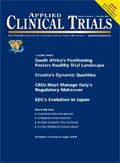Preparing for Postmarket
Applied Clinical Trials
Implementing postmarketing strategies early on to avoid on-the-spot and costly requirements upon submission.
Sweeping regulatory and government changes are pushing pharma to do more than has been expected from them in the past. No longer is the development of a clinically proven, effective, and safe drug always enough. How do drugs compare to other's being marketed for the same therapy? How has the safety and effectiveness of this drug proven itself when used in real-life?

Table: Risk Strategies-to-Date
This information is gaining more value and why it is becoming fundamental that companies begin to look at activities that were typically done in postmarket in earlier phases of a trial.
Though postmarketing research is in the FDA's hands to enforce once a submission is received, "doing the right thing at the right time will reduce cost and promote better quality of care," noted Nayan Nanavati, vice president of peri-approval clinical excellence, North America for Parexel, while presenting at CBI's conference on registries and postapproval studies this past September.
In this case, "the right thing" is more elaborate research and "the right time" is starting before the IND or NDA is submitted.
Bringing in the idea of postapproval strategies earlier will allow for these activities to be factored into trial budgets. At the same time, gaining information from such investments makes for a more concrete foundation and better assurance for a drug.
"In my group we are doing several safety-related studies, more than I have seen in the last 10 years," Nanavati offered. "And this shift has taken place in the last two years alone."
If the resources are there, current trends suggest that safety-risk initiatives should be taken regardless if there is a requirement.
Knowing your drug
The risks a drug presents should surface by the end of a Phase II trial. Acknowledging and understanding these risks while the study is still up and running enables safety-related issues to be addressed in real-time. Revisiting a trial and all the risks it presented through the entire drug development process can be taxing on a team's resources.
"If you think of [REMS] at the end of Phase II you can start implementing tools, instead of conducting postmarketing studies at the end and having those costs," explained Jill Robinson, vice president of global safety surveillance and epidemiology for Wyeth and also a speaker at CBI's conference.
If your drug presents a serious risk, preparation of a REMS is a wise step to take earlier on because upon submission the FDA will likely require it.
A step above
If a drug is not considerably risky and a REMS does not seem likely to arise in a drug's foreseeable future, comparative effectiveness research is worth deliberation. It offers better insight into a drug's true effectiveness not only to treat a condition, but also how it compares to its competitors on the market.
Similarly, patient registries also provide a unique and valuable information source for a drug's effectiveness and safety. Drugs can be evaluated for treatment of certain conditions and more specifically in various patient populations.
"Current regulatory framework, which essentially focuses on efficacy, dictates we prove that a pharmaceutical product is proven to work better than a placebo," Nanavati explained. "The regulatory process must be optimized for there to be a way to integrate observational studies before IND submission."
Gathering comparative effectiveness data on a drug gives sponsors an advantage, especially with the direction in which the health care reform is heading. If Obama's program follows through the prescribing process may see change because doctors will receive suggestions for what has been found to be the best drug for a particular condition. While this is intended to cut health care costs and avoid the use of ineffective drugs, it may very well cut reimbursements for sponsors.
With this comparative effectiveness research being collected it may become more of a factor in pharma company's go/no-go decisions.—Marissa Shapiro

Improving Relationships and Diversifying the Site Selection Process
April 17th 2025In this episode of the Applied Clinical Trials Podcast, Liz Beatty, co-founder and chief strategy officer, Inato, discusses a number of topics around site engagement including community-based sites, the role of technology in improving site/sponsor relationships, how increased operational costs are impacting the industry, and more.
Behind the Buzz: Why Clinical Research Leaders Flock to SCOPE Summit
February 7th 2025In this episode, we meet with Micah Lieberman, Executive Conference Director for SCOPE Summit (Summit for Clinical Ops Executives) at Cambridge Innovation Institute. We will dive deep into the critical role of collaboration within the clinical research ecosystem. How do we bring together diverse stakeholders—sponsors, CROs, clinical trial tech innovators, suppliers, patients, sites, advocacy organizations, investors, and non-profits—to share best practices in trial design, program planning, innovation, and clinical operations? We’ll explore why it’s vital for thought leaders to step beyond their own organizations and learn from others, exchanging ideas that drive advancements in clinical research. Additionally, we’ll discuss the pivotal role of scientific conferences like SCOPE Summit in fostering these essential connections and collaborations, helping shape the future of clinical trials. Join us as we uncover how collective wisdom and cross-industry partnerships are transforming the landscape of clinical research.